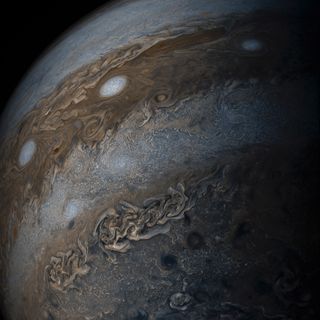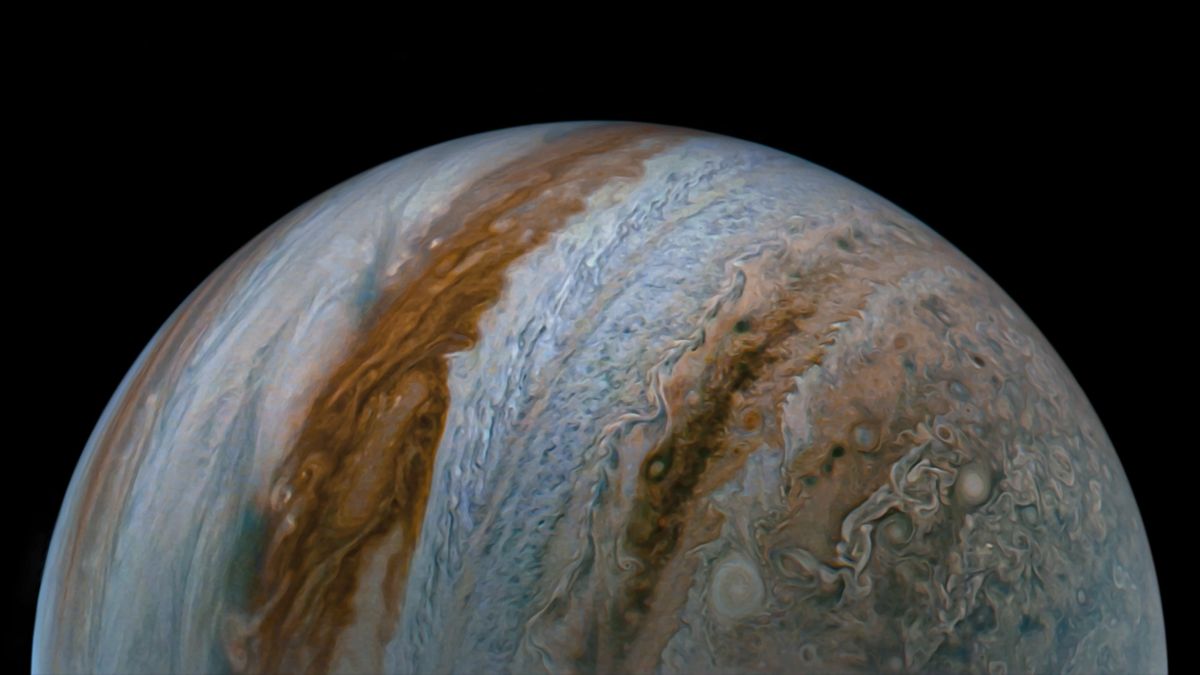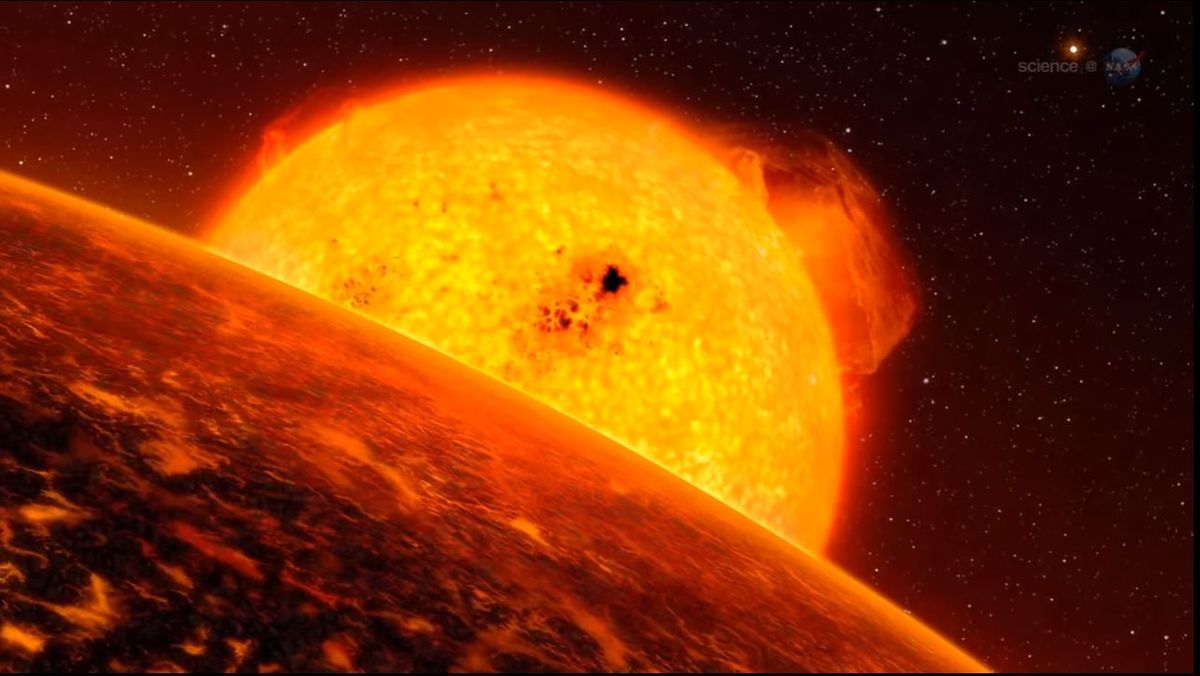It would appear that a really big storm on Jupiter can leave a noticeable mark in the planet's atmosphere.
A recent study tapped into data collected by the Jupiter-orbiting spacecraft Juno and the Hubble Space Telescope to start piecing together how this gas giant's storms churn up the world's atmosphere — even surprisingly far below the clouds. This churning involves the storms dredging up ammonia in some places and hurling it far into the Jovian depths as slushy hailstones in others.
The result, it appears, is that patches of ammonia gas end up buried deep in some parts of Jupiter’s lower atmosphere, while other areas have far less ammonia than they normally would. In other words, some storms on Jupiter can leave behind a fingerprint, reworking the whole chemical makeup of the planet's atmosphere.
Storm warning on Jupiter
A huge storm on Jupiter broke out in December of 2016, just south of the planet's equator and about 60 degrees east of the famous Great Red Spot. Amateur astronomer Phil Miles was the first to spot this storm in February of 2017 — and the timing couldn't have been better.
Juno was about to make its fourth close flyby of Jupiter, and the Atacama Large Millimeter/submillimeter Array here on Earth, along with the Hubble Space Telescope in orbit, were also pointed at the gas giant. This meant astronomers could see Jupiter in different wavelengths of light at the same time.
Armed with data from three observatories, University of California, Berkeley, planetary scientist Chris Moeckel and his colleagues just needed to figure out what kinds of updrafts, downdrafts and heat transfer could best explain what Juno, Hubble and ALMA saw during and after the storm. The team simulated the inner workings of Jupiter's atmosphere, which revealed that the massive storm had stirred up the planet's atmosphere dozens of miles below even the lowest-hanging cloud decks.
To understand exactly what that means, we first need to understand one of the quirks of describing the weather on Jupiter.

It's hard to measure altitudes in Jupiter's atmosphere, because the planet doesn't have a surface in the usual sense (there's liquid somewhere below all those deep layers of gas, but it's never been directly measured), so scientists rely on pressure instead. There's a level in Jupiter's middle stratosphere at which the atmospheric pressure is about the same as it is at sea level here on Earth, and that makes a useful baseline for saying how deep things are in Jupiter's atmosphere. The dense, heavy water vapor clouds where huge Jovian storms begin are about 82 miles (132 kilometers) below that level, where the air pressure is about 10 times higher than it is at sea level on Earth.
Furthermore, Juno's data suggests the lowest-hanging clouds present during the early 2017 storm loomed several miles lower than even that level — thus, in the storm's wake, the atmosphere had been stirred up deep, deep below the clouds.
Violent updrafts and mushy hail
Juno and Hubble images from 2017 showed a powerful updraft near the heart of the storm, pumping ammonia from deep within Jupiter's atmosphere and rushing it upward to the peaks of the towering storm clouds. Below that plume, Juno and Hubble saw that the updraft had "dried out" most of the ammonia from a patch of Jupiter's atmosphere stretching down at least tens of miles below the base of the storm clouds.
Wrapped around the bright spot of the updraft, darker patches shown in Juno's data mark where downdrafts carried a slushy mix of ammonia and water back down to the Jovian depths. And surprisingly, the ammonia was plunging much deeper into the atmosphere than Moeckel and his colleagues expected.
If the clouds in the early 2017 storm had just been raining big liquid droplets of ammonia, they shouldn't have been able to fall very deep into the atmosphere before the higher temperature and pressure evaporated the droplets — and the resulting gas wouldn't keep falling. It would just hang out, forming a new ammonia gas layer. But instead, the ammonia fell deeper — according to Moeckel and his colleagues' simulations, down to a depth where the pressure in Jupiter’s atmosphere is about 30 times higher than that at sea level on Earth. That means the storm was most likely dropping down big, slushy mush balls of mixed water and ammonia.
Mush balls are a weird weather phenomenon on Jupiter that astronomers first pieced together (also from Juno data) a few years ago.
Ammonia stays liquid at much lower temperatures than water can, which means droplets of liquid ammonia can mingle with icy crystals of water in Jupiter's storm clouds. The resulting mix is a ball of slush just solid enough to stay together, but definitely mushier than, say, a hailstone; picture a wet snowball. And mush balls raining out of a storm could fall much faster than raindrops, so they'd make it much farther before succumbing to evaporation.
The result is that deep within Jupiter's atmosphere, there are patches of ammonia that fell as mush balls from storms raging dozens of miles above – and that ammonia will stay buried down there until the next big storm dredges it up.
The scientists published their work on March 28 in the journal Science Advances.
.png)
 German (DE)
German (DE)  English (US)
English (US)  Spanish (ES)
Spanish (ES)  French (FR)
French (FR)  Hindi (IN)
Hindi (IN)  Italian (IT)
Italian (IT)  Russian (RU)
Russian (RU) 









Comments